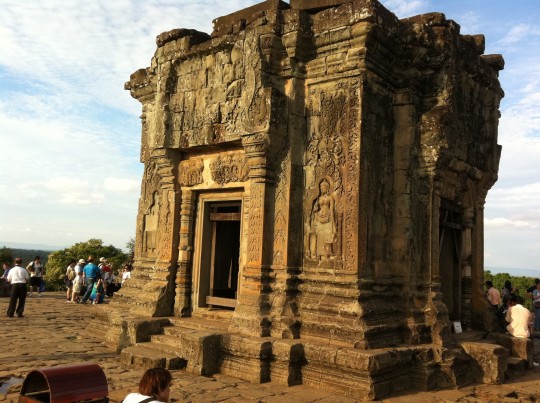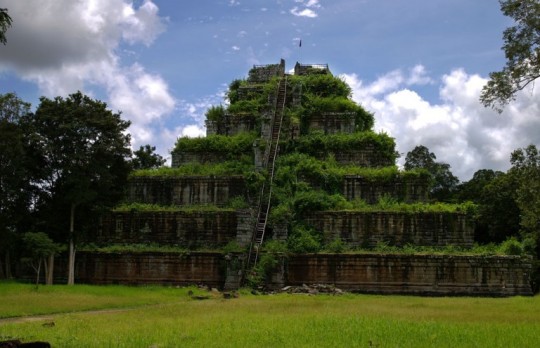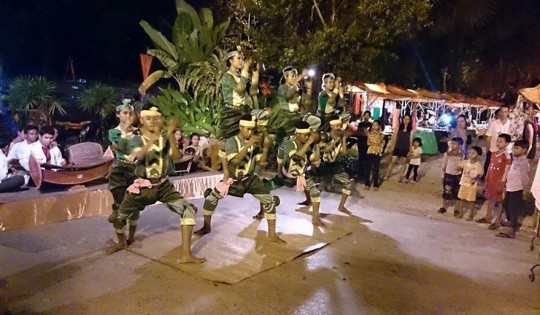Palm Tree (Borassus flabellifer): The National Tree of Cambodia
The palm tree is a kind of plant that has been widely grown in Cambodia for a long time ago. The palm tree, commonly known as Borassus flabellifer in scientific name and in Khmer called “Tnaot”, is native to the Indian subcontinent and Southeast Asia, including Nepal, India, Bangladesh, Sri Lanka, Cambodia, Lao, Burma, Thailand, Vietnam, Malaysia, Indonesia, and the Philippines.
Independence Monument
Independence Monument, or Vimean Ekareach as it is referred to in Khmer, is a majestic structure that dominates Phnom Penh city center. Erected in 1955, the Independence Monument symbolizes Cambodian Independence gained from French colonialism in 1953. It stands at the intersection of Norodom Boulevard and Sihanouk Boulevard in the center of the city.
Wat Phnom
The Wat Phnom Temple is the most significant of all the temples in Phnom Penh. The temple has a close-knitted relationship with the capital city. This in effect is a sanctuary founded by Daun Penh (Grandma Penh), a wealthy widow who in 1372, retrieved from a river a log with five Buddha statues in it and ordered to elevate a piece of her property on which to build a temple to house the statues. The 27 meters high man-made hill became known as Wat Phnom. The Chedey and temples of Wat Phnom were renovated several times, in 1434, 1806, 1894, and 1926, and each year of renovation made the sanctuary looks better.
Royal Palace (Preah Barum Reachea Veang Chaktomuk Serei Mongkol)
The Royal Palace of Cambodia is a complex of buildings although it is generally understood to be the Royal abode of the King of Cambodia. It was called in full name “Preah Barum Reachea Veang Chaktomuk Serei Mongkol”. The Royal Palace is considered as the representation of the whole nation and all temple complexes in the Royal Palace are painted in yellow, representing Buddhism, and white representing Hinduism. It faced the East and is situated at the Western bank of the cross-division of the Tonle Sap and the Mekong Rover called Chaktomuk.
The National Museum of Cambodia
The National Museum of Cambodia in Phnom Penh is the country’s leading historical and archeological museum and the country’s largest museum of history. It was officially inaugurated by King Sisowat in 1920.
Bakheng Temple-the temple of Angkor Area
When talking about Angkor's highest temple, Phnom Bakheng stands first. It offers the finest and most beautiful scenery in the surrounding region. Furthermore, the Bakheng temple is a spectacular building that attracts a lot of tourists every day from the dark until dawn. The temple is a famous and perfect place for capturing a beautiful sunrise. Many people like to get up at 5 am, go to the temple, and wait for the sunrise. After 8 or 9 am, they exit the temple to have breakfast, yet there are several other tourists who keep going up. Before evening, people start to go to the temple again around 3 to 4 pm. By the time they arrive at the top, they will wait to see another beautiful sunset view. Bakheng temple is located on the northwest side of Angkor Wat, about 1,500 meters away, generating a perfect area for viewing the world’s heritage from far.
Koh Ker Temple - The Archeological Site That Will Blow Your Mind
Nowadays, Cambodia has three World Heritage sites such as Angkor (which was listed in 1992), Preah Vihear Temple (2008), and the Temple Zone of Sambor Prei Kuk, Archeological Site of Ancient Ishanapura (2017). Furthermore, it also has five areas of culture that are considered intangible cultural heritage including the Royal Ballet, the Shadow Puppet Theatre, the Tug of War, the Long Neck Lute (Chapei), and the Khmer Male Mask Dance Drama. Koh Ker Temple is the pyramid of the Kingdom of Cambodia.
Lakhaon Khaol (Male Masked Theatre)
Many tangible and intangible heritage of Cambodia has helped the country to become well-known on the international stage and they are a vital player on the world heritage stage. One of those is Lakhaon Khol.
Robam Kandob Ses (Praying Mantis Dance)
Bakong Temple-the temples of Rolous of Angkor Area
Bakong, also known as Indresvara, is one of the most beautiful temples in Siem Reap and is the first temple mountain of sandstone built by rulers of the Khmer Empire at Angkor near modern Sime Reap in Cambodia. In the final decades of the 9th century AD, it served as the official state temple of King Indravarman I in the ancient city of Hariharalaya, located in an area that today is called Roluos.
Leak Kon Saeng (Scarf Hidden Game)
Leak Kon Saeng or Scarf Hidden Game is a kind of game that ancient Khmer children are often played as a recreation during the nighttime (under the moonlight), during the Khmer New Year season, or in between their free time.
Mondulkiri Province
Mondulkiri is one of the northeastern provinces of Cambodia which is 390 kilometers (The provincial capital is Senmonorom which is located in the southeastern part of the province) from Phnom Penh along National Road 7, 8, 76, and 141.













